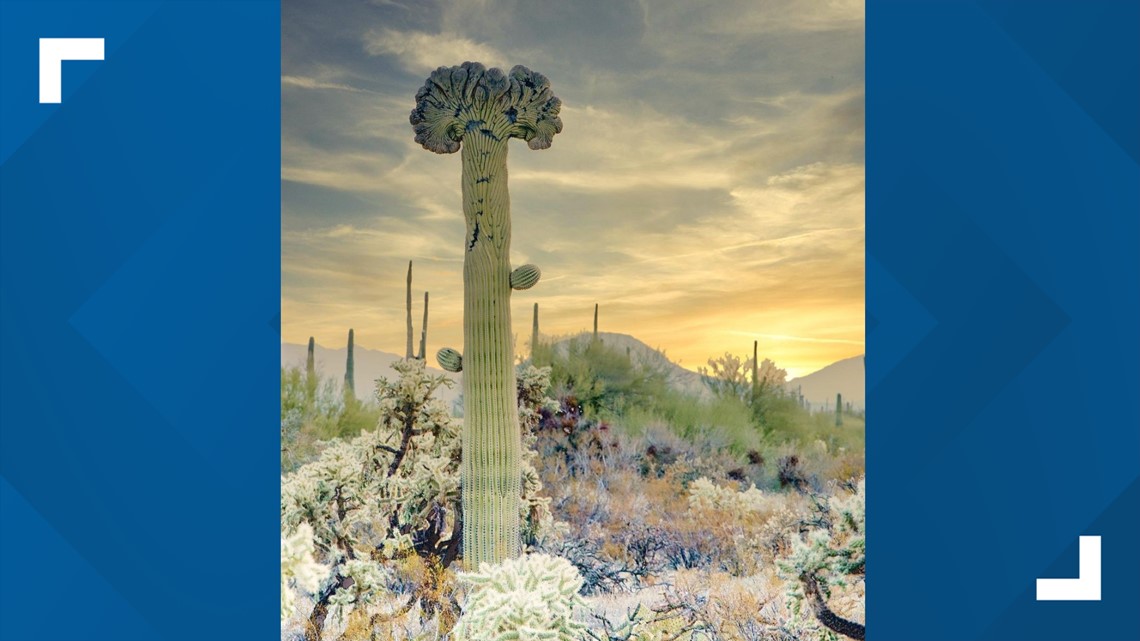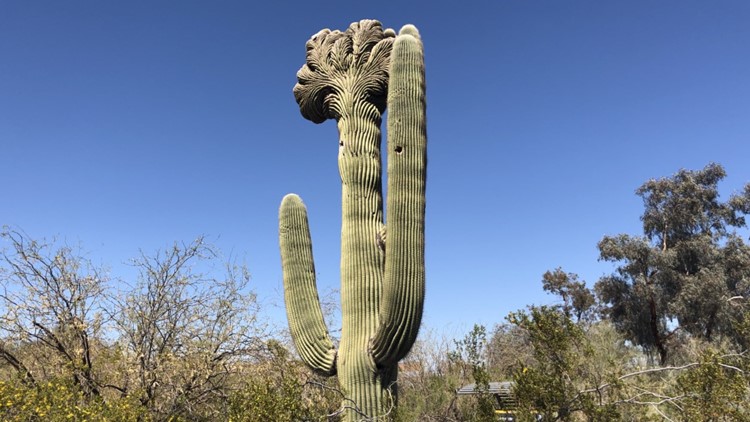PHOENIX — Stare into a sea of saguaro cacti baking under the Arizona sun and you may spot one that stands out among the rest.
Is it an oversized piece of broccoli? Nope, it’s actually an exceptionally rare example of something biologists still don’t fully understand.
Tall, green and bristling with spines, a crested saguaro cactus looks prototypical until your eyes reach its peak and see a fan-like crown.
Even if you've spent the entirety of your life in the Valley of the Sun, you couldn't be blamed for missing it. The phenomenon doesn’t happen very often.
Pat Hammes, a founding member of the Southern Arizona Hiking Club in Tucson, has tracked down just a handful of specimens in an expanse of millions of saguaros across the Sonoran Desert.


“It's absolutely beautiful,” Hammes exclaimed at the experience of seeing one first-hand. “That's the first thing I would say. They're all beautiful.”
What started as curiosity turned into a mission for Hammes and former club president Bob Cardell to learn more about the bizarre happening they would see on their weekly hikes.
“I'd looked through the binoculars, and I'd say, ‘oh boy, I spot one over here.’ And by the time we got there, we found another one,” she explained. “By the time we got to seven, we were contacted by the Cactus and Succulent Society.”
Fast forward seven years and Hammes and Cardell, who passed away last October, logged over 2,000 “cristates.”
Researchers in Pima County speculate just 1 in 200,000 saguaro cacti morph into a cristate, but no one truly understands why.
Hammes says she’s noted some patterns where they could pop up but nothing that could be called conclusive evidence.
“It just happens,” she said. “There might be 100 saguaros around, and one of them will be crested. So, it makes you wonder if water or freezing temperatures have anything to do with it, and some people speculate.”
Seeing one of the Valley's icons so strangely shaped would indeed spark curiosity in someone like Arizona State University Life Sciences professor Martin Wojciechowski.
Trained as a botanist and microbiologist, Wojciechowski came to Arizona from Michigan nearly 20 years ago with a fascination with desert fauna.
And while the cresting effect is not definitively understood, there are some details scientists have gleaned.
It’s speculated that an infection - bacterial or fungal - or severe weather can cause cells at the top of a cactus to die which leads to new cells reforming in a unique pattern.
Adding to the temperature theory is that the phenomenon is almost never observed in Mexico which doesn't see the occasional freezing temperatures like the Arizona valley, as a colleague of Wojciechowski explained to him.
Another thing researchers have noted is that becoming a cristate is not hereditary, meaning one crested saguaro will not directly produce another one.
“What's intriguing to me is that it does occur and often doesn't kill plants,” he explained. “It doesn't seem to affect them, and this unusual growth seems to persist.”
Wojciechowski says the cresting crown of the cactus just becomes another part of the plant. And with a life span of up to 150 years, the growth can be significant over time.
Even still, there is no definite explanation for something that affects such a beloved symbol of the Grand Canyon State. Whatever the reason may be, however, Wojciechowski says these "mistakes" in DNA are just a part of evolution.
"Those mistakes can be sort of beneficial, they can be detrimental, or they can be neutral in that they don't cause anything," he explained. "This is just a normal consequence of reproduction of cells."
"It's sort of like seeing a four-leaf clover, you can look through your entire lawn and see a bunch of three-leaf clovers, but occasionally, you'll find one."
So, keep an eye out for one of these crested cacti on your next run, hike or Sunday drive.
If you do stumble across one of these rarities, understand that you're staring into the heart of evolution, a mystery and a marvel of mother nature.
For more amazing nature stories across Arizona, go to the 12 News YouTube channel:



